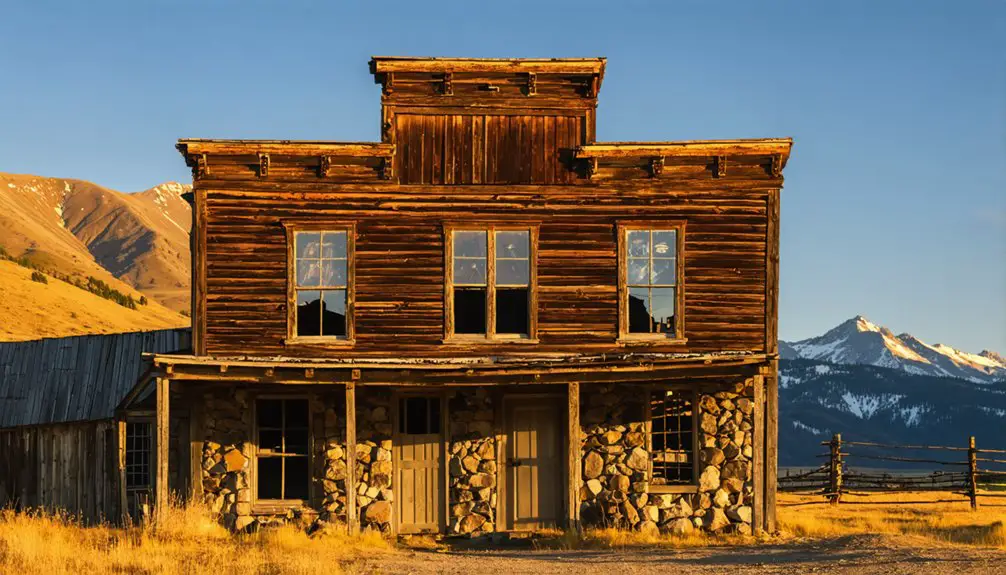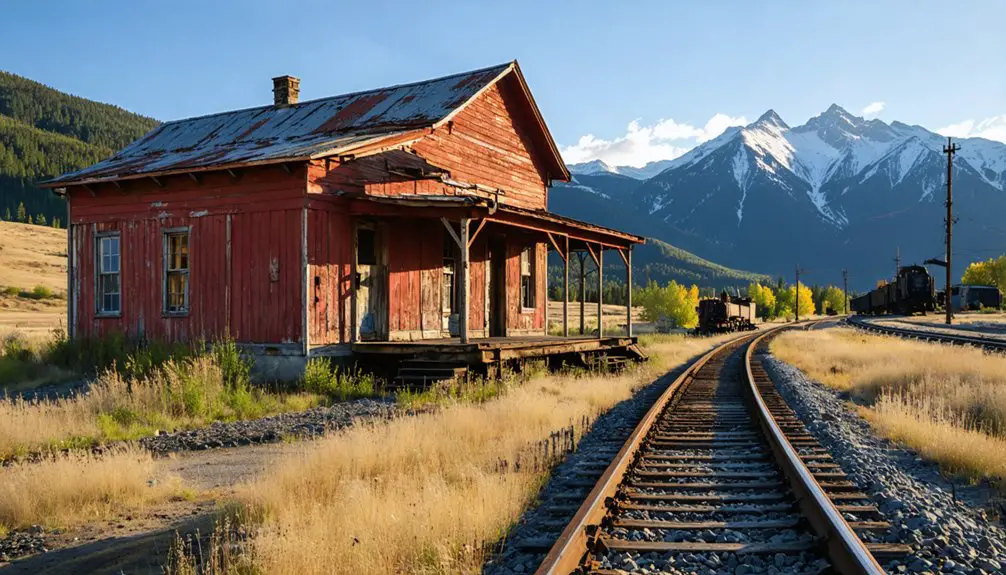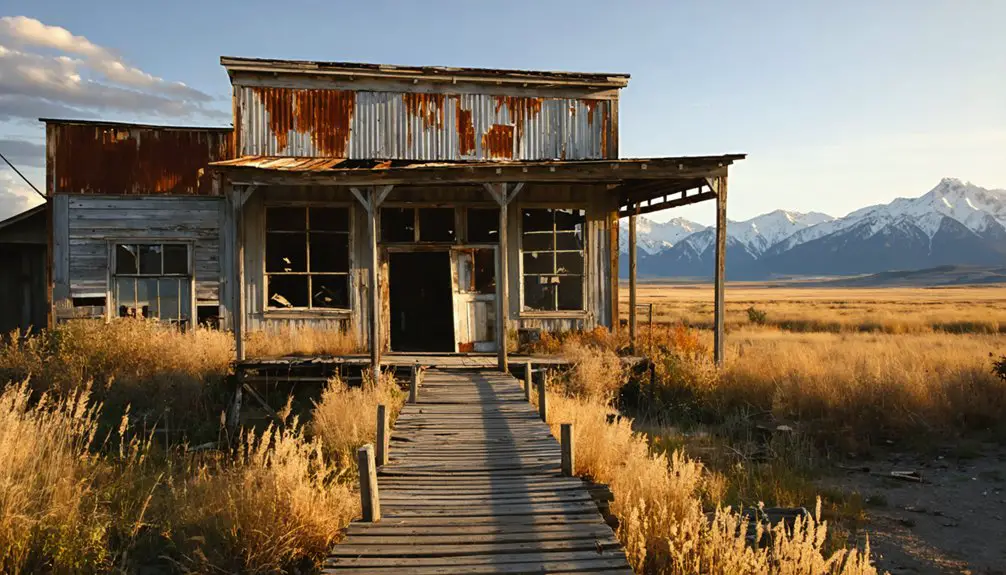You’ll discover Bearmouth nestled along Montana’s historic Mullan Road, where it served as a vital transportation hub during the 1865-1900 gold rush era. This former boomtown connected the Northern Pacific Railroad to profitable mining camps like Garnet and Coloma, featuring the iconic two-story Bearmouth Inn and essential services for weary travelers. Today, its preserved structures, including miners’ cabins and general stores, offer tangible connections to Montana’s mining heritage that reveal countless frontier stories.
Key Takeaways
- Bearmouth emerged as a vital transportation hub during Montana’s gold rush, connecting the Mullan Trail to valuable gold fields through ferry service.
- The ghost town features preserved structures including a two-story inn, livery stable, and mining-era buildings dating back to the 1890s.
- Located along Interstate 90, Bearmouth transitioned from bustling mining gateway to ghost town after mining activity declined in the early 1900s.
- The site showcases Montana’s mining heritage through surviving cabins, artifacts, and ruins that reflect the area’s million-dollar gold production legacy.
- Visitors can explore Bearmouth’s historic structures year-round through self-guided trails and connect to nearby ghost towns via Garnet Range Road.
The Gateway to Montana’s Mining Legacy
When gold was discovered in Montana’s Garnet Mining District, Bearmouth emerged as a significant gateway that would shape the territory’s mining legacy.
Montana’s gold rush transformed Bearmouth into a crucial portal, forever altering the territory’s destiny through its mining heritage.
You’ll find its cultural significance deeply rooted in both Indigenous heritage and the transformative mining era, where the Semte’use people’s ancestral lands became a bustling hub of commerce and transportation.
As you explore Bearmouth’s story, you’ll discover how John Lannan’s ferry service across the Clark Fork River connected the essential Mullan Trail to rich gold fields, while the Northern Pacific Railroad‘s arrival in 1883 established the town as a fundamental shipping point.
The area’s strategic location facilitated the transport of an estimated $10-30 million in gold yields, transforming this once-quiet valley into a pivotal nexus of Montana’s mining economy. The discovery of gold in Bear Gulch by Jack Reynolds and his party in October 1865 sparked a rush of mining activity that would define the region’s future. The population quickly swelled to five thousand men, making it one of Montana Territory’s largest mining camps.
Life Along the Historic Mullan Road
You’d have encountered Bearmouth as an essential stagecoach hub along the Mullan Road, where weary travelers could rest and replenish supplies while maneuvering through the challenging terrain between Fort Benton and Fort Walla Walla.
Your journey through this section would have required careful timing, as spring floods often damaged bridges and left portions impassable, forcing extended stays at waypoints like Bearmouth until conditions improved. The road’s construction required 230 soldiers and civilians to complete the ambitious project through difficult mountain terrain.
Engineers used precise surveying tools to determine the optimal route through the mountainous landscape. As a critical link in Montana Territory’s early supply chain, Bearmouth’s position along the Mullan Road supported the movement of essential goods and materials that sustained the region’s mining operations and settlements.
Stagecoach Travel Hub Realities
As travelers journeyed along the Mullan Road‘s 611-mile route between Fort Benton and Fort Walla Walla, Bearmouth emerged as an essential stagecoach hub where the harsh realities of mountain travel demanded strategic rest and resupply.
You’d face treacherous conditions traversing the 25-foot-wide passages through dense forests and steep mountain passes, where stagecoach operations required frequent horse changes and maintenance stops. The road’s construction by over 200 workers made such travel possible, though still challenging. The need for meticulous campsite planning meant locations were chosen near water and forage.
The town’s infrastructure of inns, stables, and corrals supported your survival against extreme weather and challenging terrain.
Travel challenges included maneuvering through carefully engineered fords, bridges, and retaining walls, while skilled drivers guided wagons through the rugged landscape.
Bearmouth’s position as a critical resupply point meant you’d find blacksmiths, farriers, and other essential services to guarantee your continued journey.
Supply Chain Transportation Legacy
The historic Mullan Road revolutionized supply chain logistics across the American Northwest, establishing an essential 611-mile transportation corridor between Fort Benton and Fort Walla Walla.
You’ll find that this engineering marvel, though costly at $230,000, proved instrumental in developing Montana’s economic landscape during the gold rush era.
As you trace the route’s legacy, you’ll discover how pack trains of up to 100 animals transported necessary supplies, moving an impressive 750 tons of freight valued at $1.44 million in 1865 alone.
The road’s impact on supply chain development can’t be understated – it created critical transportation routes that would later influence the paths of Interstate 15 and Interstate 90, permanently shaping the region’s commercial infrastructure and connecting western territories to national markets.
Construction crews used picks and black powder to carve through challenging mountain terrain, creating passages wide enough for single wagons to pass. The road underwent significant repairs in 1877 to maintain its vital supply chain function under General Sherman’s orders.
From Stagecoach Stop to Ghost Town
If you’d visited Bearmouth during its heyday in the late 1800s, you’d have found yourself at a bustling transportation hub where the two-story balconied inn and livery stable served countless travelers along the historic Mullan Road.
Your stagecoach would have been one of many carrying passengers and goods between the thriving mining camp of Garnet and other regional destinations, marking Bearmouth’s essential role in Montana’s mining economy.
Today, you’ll find only the weathered remains of the inn and stable standing as silent witnesses to Bearmouth’s golden era, their presence along modern Interstate 90 offering a tangible connection to Montana’s frontier past. The area yielded an impressive million in gold during 1866 alone, drawing fortune seekers from across the country. The connection to Garnet became especially vital after the town was established in 1895, when it was initially named Mitchell before becoming the Garnet we know today.
Transportation Hub’s Golden Era
During the late 1800s, Bearmouth emerged as an essential transportation nexus along the historic Mullan Road, serving both as a primary stagecoach stop and shipping hub between Montana and the Pacific Northwest.
You’d find stagecoaches carrying up to 18 passengers stopping at the town’s prominent two-story balconied inn, where transportation innovations like rapid horse-changing stations kept schedules running smoothly.
As a significant waypoint on the 624-mile Mullan Road – the first wagon route across the Rockies – Bearmouth buzzed with community gatherings at the inn’s first-floor social spaces.
The town’s strategic location near the Clark Fork River made it indispensable for shipping ore from nearby mining operations, particularly Garnet.
Businesses flourished, with blacksmiths, bars, and lodging services catering to the steady stream of travelers and miners.
Legacy in Modern Times
Once thriving as Montana’s essential transportation hub, Bearmouth experienced a dramatic transformation by the early 1900s as mining activity declined and newer transportation routes bypassed the town.
You’ll find remnants of its $1 million gold and silver production legacy scattered across the landscape, with dilapidated structures telling tales of boom-and-bust cycles.
While economic revival hasn’t materialized in traditional ways, Bearmouth’s ghost town tourism potential connects visitors to Montana’s rich mining heritage.
You can explore surviving cabins and mining artifacts that offer glimpses into frontier life, while local folklore, including stories of buried treasure and the notorious “Beartown Roughts,” keeps the town’s spirit alive.
As part of Montana’s network of historic mining settlements, Bearmouth stands as a reflection of the American West’s dynamic past.
Shipping Hub of the Garnet Range
As the Northern Pacific Railroad established operations in 1883, Bearmouth emerged as the primary railway shipping point for the Garnet mining district‘s valuable ore exports.
The town’s strategic location along the Mullan Trail, coupled with John Lannan’s ferry service, created an essential transportation hub that you’ll recognize as significant to Montana’s mining heritage.
Bearmouth’s prime position and ferry crossing transformed it into a vital nexus for Montana’s thriving mining operations.
You’ll find Bearmouth’s mining connections evident in the network of wagon roads, spanning 3 to 10 miles, that linked the railhead to bustling camps like Garnet and Coloma.
The town’s infrastructure facilitated the shift from small-scale placer operations to extensive lode mining, enabling efficient bulk shipments to distant markets.
This fundamental role in ore transportation helped sustain the region’s economic vitality throughout the late 19th century’s mining booms.
The Legendary Bearmouth Inn

As you explore the remains of Bearmouth’s legendary Inn, you’ll find a striking two-story structure with its distinctive balcony that once welcomed weary stagecoach travelers along the Mullan Road.
The Inn’s preserved architectural features, including its frontier-era construction style and adjacent livery stable ruins, stand as evidence to its essential role in Montana’s late 19th-century transportation network.
From its balcony rooms, countless miners, merchants, and passengers witnessed the bustling activity of ore shipments and stagecoaches that defined Bearmouth’s identity as an important service hub rather than a mining camp.
Historic Stagecoach Stop Legacy
During the vibrant era of 19th-century stagecoach travel, the Bearmouth Inn emerged as an essential waypoint along Montana’s Mullan Road, serving weary travelers between mining settlements and frontier communities.
You’ll find that stagecoach operations at Bearmouth exemplified the untamed spirit of the American West, with historical anecdotes painting a picture of bustling activity as fresh horses were swiftly exchanged and travelers sought refuge from their arduous journeys.
- Skilled coordination between stage crews could change out tired horses in mere minutes
- Up to 18 passengers would share communal facilities, including wells and washing stations
- The inn’s first floor featured a lively bar and gambling area, drawing both locals and travelers
- Strategic positioning along the route made Bearmouth a vital link in Montana’s transportation network
Architectural Features Remain Today
The legendary Bearmouth Inn stands today as a symbol to late 19th-century frontier architecture, with its distinctive two-story design and prominent balcony remaining largely intact.
You’ll find the building’s historical significance preserved in its original façade, where the upper floor windows and balcony continue to capture the essence of Montana’s stagecoach era.
Now known as the Bearmouth Chalet, the structure maintains its architectural preservation through its weathered yet enduring exterior walls and authentic structural frame.
While the interior layout remains undocumented, the building’s robust construction using local wood and stone materials exemplifies typical frontier craftsmanship.
This architectural landmark, now part of an RV park, serves as a tribute to Bearmouth’s role as an essential transportation hub during Montana’s pioneering days.
Tales From Balcony Rooms
Life within the Bearmouth Inn’s storied balcony rooms embodied the untamed spirit of Montana’s mining era, where miners, travelers, and local characters converged in a uniquely social spectacle.
You’d find these elevated spaces serving as stages for the town’s most colorful social gatherings, from heated gambling sessions to impromptu political debates. The wooden-railed balconies offered prime vantage points for observing street life below, while hosting their own share of memorable events.
- Clandestine meetings among mining magnates shaped the region’s economic future
- Funeral celebrations transformed the balconies into gathering spaces for community mourning
- Nightly entertainment and storytelling sessions drew crowds from across the territory
- Local disputes often erupted into legendary confrontations, cementing the Inn’s rough reputation
Economic Ties to Surrounding Mining Camps

While gold discoveries in Bear Gulch and surrounding areas drove Montana’s mining boom, Bearmouth’s strategic location established it as an important economic hub connecting numerous mining camps.
You’ll find evidence of robust mining partnerships between Bearmouth and camps like Garnet, Coloma, and Beartown, where up to $30 million in placer gold flowed through the area.
As a crucial transportation nexus, Bearmouth’s ferry crossing, stagecoach stop, and Northern Pacific Railroad station facilitated the movement of ore, supplies, and workers throughout the region.
Economic fluctuations tied to seasonal mining operations and ore production impacted all connected settlements.
The town’s infrastructure, including hotels and freight services, supported the complex web of commerce between Bear Gulch, Elk Creek, Deep Creek, and Bilk Gulch mining districts.
Tales and Legends of Bearmouth
During the late 1800s, Bearmouth and its neighboring mining towns spawned numerous tales and legends that persist today.
You’ll discover stories of ghostly encounters in the Wells Hotel, where unexplained footsteps and slamming doors cease when investigated. The region’s rich mining heritage has attracted countless treasure hunters searching for a legendary fortune buried in a five-pound baking can by a Chinese resident.
- Reports of supernatural activity in Garnet’s abandoned buildings, particularly the hotel and saloon
- Tales of hidden gold veins and sealed mine shafts awaiting rediscovery
- Stories of a vibrant social scene, with dances and gatherings contrasting the typical lawless mining camp
- Accounts of remarkable gold discoveries, including a 32-ounce nugget from Bilk Creek that sparked a rush
Preserving Montana’s Transport History

Beyond the colorful tales of Bearmouth’s past lies a complex network of preservation efforts aimed at protecting Montana’s transportation heritage.
You’ll find MDT working closely with the Montana Historical Society to safeguard historically significant sites through programs like CTEP and the Adopt-A-Bridge initiative. Understanding the historical significance of these transportation corridors isn’t just about nostalgia – it’s about preserving tangible links to Montana’s development.
Montana’s transportation heritage lives on through partnerships and programs dedicated to protecting the physical landmarks of our state’s growth.
While funding mechanisms like TIF and Coal Trust provide some support, you’re looking at significant challenges in maintaining these historic structures.
Modern traffic demands and safety requirements often conflict with preservation goals. Yet through MDT’s Section 106 Programmatic Agreement and collaborative documentation efforts, you’re witnessing a determined push to protect these irreplaceable assets before they disappear from Montana’s landscape forever.
Exploring the Remaining Structures
The remaining structures of Bearmouth paint a vivid portrait of Montana’s mining era through an assemblage of miners’ cabins, general stores, saloons, and the iconic J.K. Wells Hotel ruins.
These architectural treasures, dating back to the 1890s, showcase the cultural significance of Montana’s hard rock mining period, with over 30 preserved buildings in the nearby Garnet area.
- Original cabin walls reveal historical building practices, insulated with period newspapers and catalogs
- Year-round access lets you explore structures via self-guided trails with interpretive signage
- Buildings contain authentic period items, preserving the essence of frontier commerce
- Bureau of Land Management’s preservation efforts maintain structural integrity while allowing public exploration
You’ll find these architectural preservation efforts have kept Bearmouth’s rugged spirit alive, offering an unvarnished glimpse into Montana’s mining heritage.
A Year-Round Historical Destination
While many ghost towns become inaccessible in harsh weather, Bearmouth‘s strategic location at 3,802 feet elevation along Interstate 90 guarantees year-round visitation opportunities.
You’ll find the climate supports consistent Bearmouth exploration throughout all seasons, with winters cold but manageable and summers ideal for examining the historic structures.
Your historical preservation experience isn’t limited to Bearmouth alone. You can venture through a 13-mile loop along Garnet Range Road to discover interconnected mining camps like Reynolds City, Springtown, and the well-preserved Garnet ghost town.
The area’s authentic character remains largely uncommercialized, allowing you to examine original structures like the two-story balconied inn and livery stable that once served countless travelers along the old Mullan Road.
Frequently Asked Questions
How Deep Were the Original Gold Mines Near Bearmouth?
You’ll find gold mine depths varied from surface placer operations to underground quartz mining shafts reaching several hundred feet deep. Early mining techniques included both hydraulic surface extraction and deeper hard-rock tunneling.
What Happened to the Original Residents After the Town’s Decline?
You’ll find residents’ migration patterns led them to nearby towns like Missoula and Drummond seeking jobs, while others moved to larger Montana cities. Ghost town stories reveal they adapted to wartime industries and railroad work.
Were There Any Notable Crimes or Lawmen in Bearmouth’s History?
You’ll find few records of notable criminals or legendary lawmen in Bearmouth’s past, though nearby Garnet maintained a jail and controlled rowdy behavior through local law enforcement efforts.
Did Native American Tribes Interact With Bearmouth During Its Operation?
You’ll find that Salishan tribes, especially the Semte’use and Flathead, maintained tribal relations with Bearmouth, continuing their traditional resource gathering while engaging in limited cultural exchanges with settlers through the town’s operational period.
What Was the Maximum Population of Bearmouth During Its Peak Years?
You’ll find precise population records are unavailable, but based on gold rush patterns and mining techniques of the 1860s, Bearmouth’s peak population was likely under 1,000, smaller than nearby Garnet’s 1,200 residents.
References
- https://glaciermt.com/ghost-towns
- https://avrextravel.com/montana-ghost-towns/
- https://www.legendsofamerica.com/mt-garnet/
- https://www.ghosttowns.com/states/mt/bearmouth.html
- https://www.ultimatemontana.com/southwest montana/3353-2021-03-24-23-33-57
- http://granitecountyhistory.blogspot.com/2013/03/garnet-mining-district.html
- https://oldmissoula.com/beartown-history-by-mary-j-pardee/
- https://granitecountyhistory.blogspot.com/2024/03/bearmouth-and-weaver-archeological.html
- https://www.blm.gov/sites/default/files/docs/2021-07/THE ROAD TO GARNET’S GOLD (002).pdf
- https://westernmininghistory.com/mine-detail/10196576/



